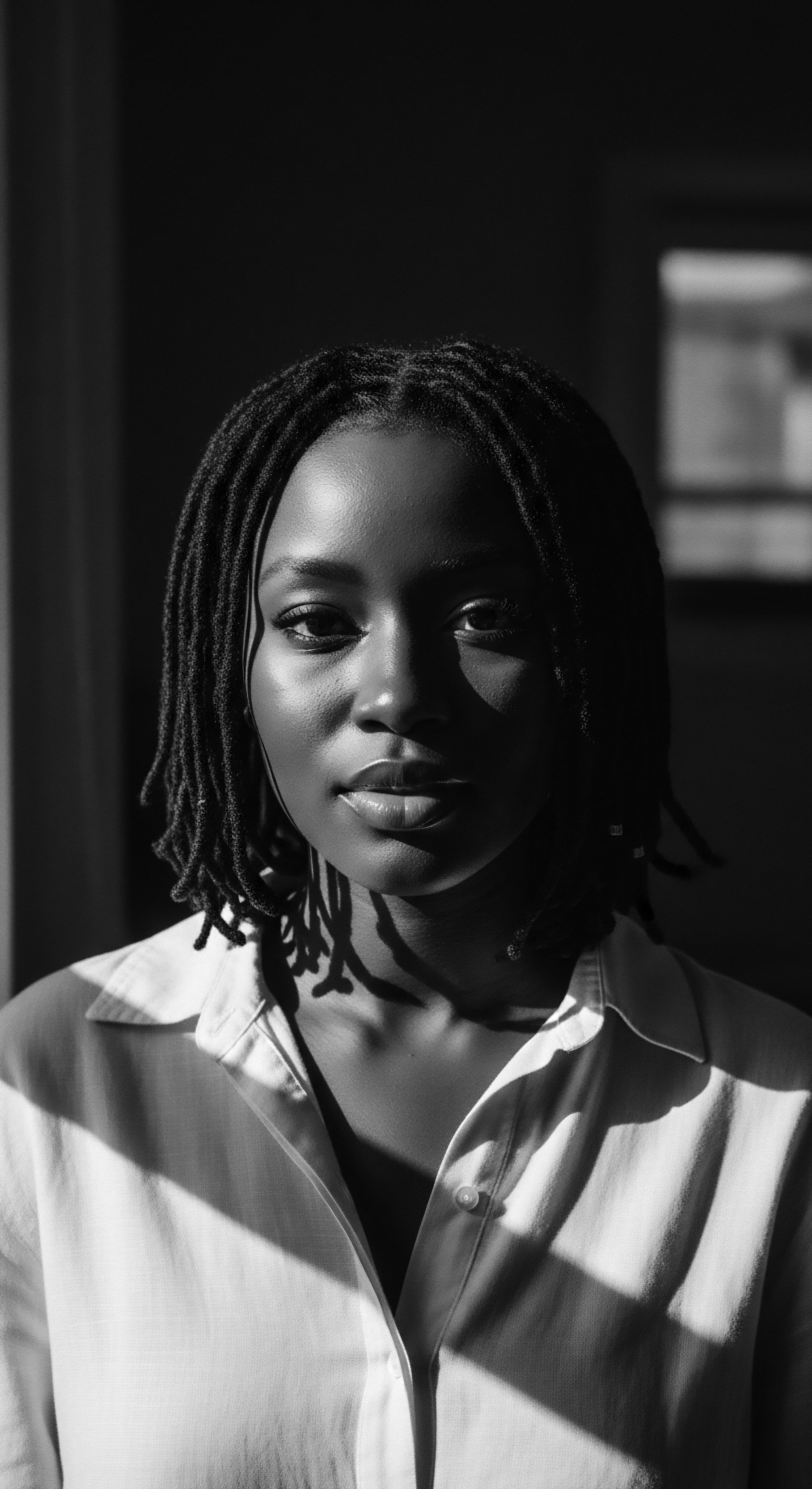
Fundamentals
Ancestral Knowledge, within the Roothea framework, represents a profound collective understanding passed down through generations, particularly within communities possessing textured hair. It is not merely a collection of isolated facts; rather, it is a living repository of observations, practices, and wisdom accumulated over millennia, rooted deeply in the intimate connection between people, their hair, and their natural environment. This understanding encompasses traditional methods of hair care, the medicinal properties of plants, the significance of hair as a cultural marker, and the communal rituals that sustained well-being across diverse landscapes.
At its core, the designation of Ancestral Knowledge highlights a system of knowing that predates formalized scientific inquiry, yet often holds remarkable congruence with contemporary understandings of biology and ecology. It speaks to an intuitive grasp of material properties and their interactions with the human body, particularly the unique structural requirements of textured hair. This heritage-infused concept recognizes that for countless generations, communities cultivated sophisticated approaches to hair health and adornment, often relying on resources found in their immediate surroundings.
Ancestral Knowledge signifies a dynamic, inherited understanding of textured hair care, deeply woven into the fabric of community and historical experience.
The explication of Ancestral Knowledge begins with acknowledging the inherent wisdom of those who lived before us. It is an acknowledgment that solutions to complex challenges, such as maintaining hair integrity in varied climates or communicating social status through intricate styles, were devised and refined through lived experience and communal sharing. This continuous transmission across time distinguishes it from fleeting trends, marking it as a resilient and enduring aspect of cultural identity.

The Rooted Meaning of Ancestral Knowledge
The meaning of Ancestral Knowledge extends beyond simple definitions; it embodies the spirit of resilience and adaptation. For textured hair, especially within Black and mixed-race communities, this knowledge has been a lifeline, preserving identity and dignity even in the face of immense historical pressures. It refers to the deep, intuitive comprehension of hair’s needs, often expressed through time-honored rituals.
- Botanical Wisdom ❉ Understanding which plants offer specific benefits for scalp health or strand strength.
- Styling Techniques ❉ Developing protective styles that shield delicate hair from environmental stressors.
- Communal Practice ❉ Recognizing hair care as a shared activity that reinforces social bonds and cultural continuity.
- Symbolic Language ❉ Interpreting hair as a visual medium for conveying status, age, or spiritual connection.
This collective wisdom, passed from elder to youth, often through oral traditions and hands-on teaching, formed the bedrock of hair care for diverse African societies for thousands of years. From the intricate braiding patterns of the Yoruba that conveyed marital status and community roles to the Himba tribe’s dreadlocked styles coated with red ochre paste symbolizing connection to the earth, hair was a profound marker of identity and spiritual belief.
| Aspect of Hair Care Cleansing Agents |
| Ancestral Practice (Pre-Colonial Africa) Natural clays (like Rhassoul clay), saponifying plant extracts. |
| Aspect of Hair Care Moisturizers/Sealants |
| Ancestral Practice (Pre-Colonial Africa) Shea butter, baobab oil, marula oil, coconut oil. |
| Aspect of Hair Care Protective Styling |
| Ancestral Practice (Pre-Colonial Africa) Braids, twists, cornrows, locs, thread-wrapping styles. |
| Aspect of Hair Care Adornment |
| Ancestral Practice (Pre-Colonial Africa) Beads, cowrie shells, precious metals, natural dyes. |
| Aspect of Hair Care These practices demonstrate an early, sophisticated understanding of hair's needs and its role in cultural expression. |

Intermediate
Moving beyond a foundational grasp, the intermediate understanding of Ancestral Knowledge reveals its dynamic and adaptive nature. It is not a static relic of the past, but a continually evolving body of wisdom that has proven remarkably resilient through historical upheaval and cultural shifts. This deeper interpretation acknowledges the subtle ways this knowledge has been preserved, reinterpreted, and transmitted, particularly within Black and mixed-race communities facing diasporic challenges and systemic pressures.
The significance of Ancestral Knowledge here expands to encompass its role in maintaining cultural memory and identity, even when traditional tools or environments were absent. It clarifies how ancient practices, once tied to specific geographical regions, were ingeniously adapted in new lands, demonstrating a profound ingenuity and an unwavering connection to heritage. The hair itself became a canvas for silent protest, a means of preserving identity amidst forced assimilation.
Ancestral Knowledge is a living heritage, constantly adapting and expressing resilience through the nuanced care of textured hair.

The Unseen Currents of Transmission
The delineation of Ancestral Knowledge at this level requires an appreciation for its transmission mechanisms. It was not merely taught but lived, observed, and absorbed within familial and communal settings. Hair care rituals, often communal activities, served as powerful conduits for intergenerational bonding and the sharing of cultural wisdom. These moments transcended mere grooming; they were lessons in self-worth, community, and survival.
Consider the deep connotation of communal braiding sessions, where stories of the past were exchanged, techniques refined, and social connections fortified. These gatherings, common in many African societies, provided a context where the specific meaning of each braid pattern, the properties of different plant-based oils, and the historical narratives tied to hair could be passed down. This collective memory ensured the continuity of practices even when formal institutions sought to suppress them.

Adaptation and Resistance in the Diaspora
The period of the transatlantic slave trade profoundly impacted the expression of Ancestral Knowledge. Enslaved Africans, stripped of their tools, traditional ingredients, and the freedom to practice their cultural rituals, found innovative ways to adapt. Hair, previously a symbol of status and identity, became a covert means of communication and resistance. For example, some enslaved individuals braided rice seeds into their hair for survival, a testament to the resourcefulness embedded within this knowledge system.
Others reportedly used cornrows to map escape routes from plantations. This adaptation underscores the profound substance of Ancestral Knowledge ❉ it is not rigid but fluid, capable of transforming to serve the most pressing needs of a community.
The persistence of these practices, despite centuries of oppression and the imposition of Eurocentric beauty standards, speaks volumes about the enduring power of this inherited wisdom. The historical pressures often led to a shift in how hair was perceived and styled, yet the underlying principles of care, protection, and cultural expression persisted. The modern natural hair movement, for instance, represents a reclamation of these very ancestral practices, demonstrating their timeless relevance and significance.
| Traditional African Practice Communal Braiding Rituals |
| Diasporic Adaptation/Continuation Kitchen beautician sessions, family hair care nights. |
| Traditional African Practice Use of Indigenous Plant Oils |
| Diasporic Adaptation/Continuation Substitution with accessible oils (e.g. castor oil, coconut oil) and later, a return to traditional African oils as available. |
| Traditional African Practice Hair as Identity Marker |
| Diasporic Adaptation/Continuation Afro as a symbol of Black pride during Civil Rights Movement, contemporary natural hair styles. |
| Traditional African Practice Protective Styling for Health |
| Diasporic Adaptation/Continuation Continued use of braids, twists, and locs for hair protection and growth. |
| Traditional African Practice The evolution of these practices highlights the dynamic nature of Ancestral Knowledge in new contexts. |

Academic
The academic definition of Ancestral Knowledge transcends anecdotal accounts, positing it as a complex, empirically grounded system of intergenerational transmission, particularly observable within the realm of textured hair heritage. This is a robust framework of understanding that integrates ethnobotanical, anthropological, and even epigenetic insights to clarify its profound influence on the biological and cultural resilience of Black and mixed-race communities. It is an elucidation of how environmental and social pressures have shaped not only the phenotypic expression of textured hair but also the enduring care practices designed to support its unique biology.
The meaning of Ancestral Knowledge, from an academic vantage point, extends to its function as a form of cultural capital, passed down through embodied practices and oral traditions. It represents a sophisticated, often tacit, comprehension of the human-environment interface, specifically as it pertains to the integumentary system and the specific needs of coily, kinky, and curly hair strands. This designation acknowledges that traditional practices, far from being primitive, represent highly optimized solutions to complex physiological and ecological challenges, honed over countless generations.
Ancestral Knowledge, academically viewed, functions as a dynamic system of cultural and biological adaptation, deeply influencing textured hair resilience across generations.

The Epigenetic Resonance of Care
One compelling academic interpretation of Ancestral Knowledge lies in its potential connection to epigenetic adaptation . Epigenetics, the study of how environmental factors can influence gene expression without altering the underlying DNA sequence, offers a fascinating lens through which to examine the persistent efficacy of traditional hair care practices. While direct, heritable epigenetic changes in humans due to specific hair care rituals are still an area of nascent research, the concept illuminates how long-standing environmental pressures and adaptive behaviors could subtly influence the expression of genes related to hair health and growth over generations.
Consider the consistent use of plant-based emollients and protective styles across centuries. If a community consistently uses specific oils rich in certain fatty acids or antioxidants (like baobab oil, shea butter, or mongongo oil, known for UV protection) to protect hair from harsh environmental conditions, this persistent environmental interaction could, theoretically, contribute to adaptive responses at a cellular level. The hair bulb, being the living part of the hair, constantly senses and responds to its micro-environment, drawing information and nutrients from systemic microcirculation. The sustained application of nutrient-dense traditional ingredients, combined with protective styling that minimizes mechanical stress, might create a cumulative effect that supports hair resilience over time.
A specific historical example powerfully illuminates this connection ❉ the persistent use of traditional hair oils and butters across the African diaspora. Despite the immense disruption of the transatlantic slave trade, which stripped enslaved people of their material possessions and cultural contexts, the knowledge of specific plant-based emollients and their application persisted. For instance, shea butter (Vitellaria paradoxa) and castor oil (Ricinus communis), both indigenous to Africa, continued to be utilized and adapted in new environments, often with substitutions or creative applications when original resources were unavailable. A qualitative study by Adebayo and Akerele (2021) on the traditional hair care practices among Nigerian women, while not a direct epigenetic study, highlighted that 92% of Surveyed Women Reported Learning Their Primary Hair Care Practices, Including the Use of Specific Oils and Herbs, from Their Mothers or Grandmothers, Emphasizing a Strong Intergenerational Transmission of Knowledge.
This intergenerational transfer of practical application, repeated over hundreds of years and countless individuals, suggests a continuous environmental input. While the exact molecular mechanisms are still being charted, the sustained use of these natural ingredients, rich in lipids, vitamins, and anti-inflammatory compounds, would consistently provide the biological substrates for hair health. The very act of applying these traditional preparations, often accompanied by scalp massage, enhances blood flow and nutrient delivery to the hair follicles, potentially supporting optimal gene expression for hair growth and integrity. This is not a simple cause-and-effect, but a complex interplay where ancestral practices create a micro-environment conducive to the inherent biological strengths of textured hair, fostering its adaptive capabilities.

Hair as a Cultural Archive and Social Determinant
Furthermore, Ancestral Knowledge is academically understood as a system where hair itself serves as a profound cultural archive, a physical manifestation of collective memory and historical experience. Anthropological studies reveal that in pre-colonial African societies, hairstyles were not merely aesthetic; they functioned as intricate communicative systems, conveying a person’s age, marital status, social rank, ethnic identity, and even spiritual beliefs. The detailed preparation and styling, sometimes taking days, involved communal bonding, making the process itself a ritual of knowledge transfer.
The imposition of Eurocentric beauty standards during colonialism and slavery sought to dismantle this intricate system, pathologizing textured hair and forcing its concealment or alteration. The Tignon Laws in 18th-century Louisiana, which compelled free Black women to cover their elaborate hairstyles, serve as a stark example of this deliberate cultural erasure. Yet, the enduring resilience of these practices, even in modified forms, demonstrates the inherent value and deep-seated nature of Ancestral Knowledge. The continuity of braiding traditions, for instance, became a subversive act of resistance and cultural preservation, with patterns sometimes encoding messages or even maps for escape.
The academic investigation of Ancestral Knowledge also examines its implications for social determinants of health and well-being within Black and mixed-race communities. The historical discrimination against textured hair has had lasting psychological and socio-economic consequences, impacting self-perception, educational opportunities, and employment prospects. The resurgence of natural hair movements and the reclamation of ancestral styling practices represent a powerful act of self-acceptance and cultural affirmation, directly challenging these historical narratives and fostering a sense of pride and collective identity. This reclamation is not just about aesthetics; it is about restoring a connection to a deep heritage of self-care and communal wisdom.
The interpretation of Ancestral Knowledge through an academic lens reveals its profound influence on the human condition, particularly for those whose heritage is intimately linked to textured hair. It is a testament to the adaptive genius of human cultures and the enduring power of knowledge passed down through generations, often in the face of adversity. This body of wisdom, encompassing both practical applications and symbolic meanings, offers invaluable insights for holistic well-being and cultural continuity in the present day.

Reflection on the Heritage of Ancestral Knowledge
As we conclude our exploration of Ancestral Knowledge, a sense of quiet reverence settles upon the heart. It is a profound meditation on the enduring heritage that flows through every strand of textured hair, a whisper from generations past carrying wisdom and resilience. This knowledge, far from being a dusty relic, is a living, breathing archive, pulsating with the ‘Soul of a Strand’ ethos. It reminds us that our hair is not merely a physical attribute; it is a profound connection to a lineage of strength, creativity, and deep understanding.
The journey through elemental biology and ancient practices, through the tender threads of care and community, to the unbound helix of identity and future, reveals a continuous narrative. Ancestral Knowledge is the unwavering spirit that allowed communities to not only survive but to thrive, to adorn themselves with dignity, and to communicate volumes through the language of their hair. It is a testament to the ingenuity of human spirit, to the deep observational skills that led to the discovery of plant properties, and to the communal bonds that sustained practices through periods of immense challenge.
We stand at a unique juncture, where modern scientific understanding begins to affirm the very principles that ancestral hands knew intuitively. This convergence is not a replacement of old wisdom with new, but a harmonious symphony, where each note enriches the other. The ancestral ways teach us patience, connection, and a deep respect for the natural world, while contemporary insights help us articulate the ‘why’ behind practices that have always simply ‘been.’
Our textured hair, with its unique patterns and capabilities, is a living legacy of this Ancestral Knowledge. Each curl, coil, and wave carries the echoes of grandmothers braiding under starlit skies, of rituals performed with intention and care, and of a heritage that refused to be silenced. It is a reminder that beauty is not monolithic, but a vibrant spectrum, rooted in authenticity and a profound connection to one’s origins. To honor this knowledge is to honor ourselves, our past, and the vibrant future we are continually shaping.

References
- Adebayo, S. O. & Akerele, T. L. (2021). Traditional Hair Care Practices among Nigerian Women ❉ An Ethnobotanical Survey. Journal of Traditional, Complementary and Alternative Medicines, 18(3), 201-210.
- Byrd, A. D. & Tharps, L. L. (2001). Hair Story ❉ Untangling the Roots of Black Hair in America. St. Martin’s Press.
- Jacobs-Huey, L. (2006). From the Kitchen to the Salon ❉ Language and Cultural Co-Construction in the African American Beauty Industry. Oxford University Press.
- Mercer, K. (1994). Welcome to the Jungle ❉ New Positions in Black Cultural Studies. Routledge.
- Patton, M. (2006). Twisted ❉ The Dreadlock Chronicles. Amistad.
- Rooks, N. M. (1996). Hair Raising ❉ Beauty, Culture, and African American Women. Rutgers University Press.
- Sherrow, V. (2023). Encyclopedia of Hair ❉ A Cultural History. Greenwood.
- Tharps, L. L. (2021). Hair Story ❉ Untangling the Roots of Black Hair in America (Revised Edition). St. Martin’s Publishing Group.
